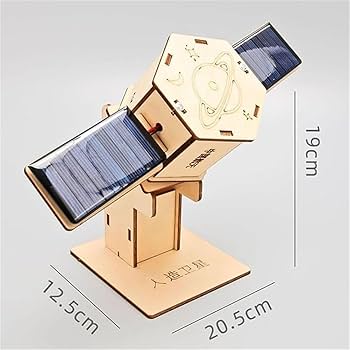Model satellites offer a unique blend of hands-on creativity, scientific curiosity, and a love for space technology. Whether you’re a space enthusiast, a student, or a seasoned model builder, crafting a miniature satellite can be a rewarding and educational experience. This guide will walk you through the essentials of building your own model satellite at home.
Why Build a Model Satellite?
- Educational Value: Learn how real satellites function and are constructed.
- STEM Engagement: Perfect for teaching kids or students about orbits, electronics, and space science.
- Display Piece: A completed satellite model makes for a stunning desk or shelf display.
- DIY Challenge: It’s a fun way to test your patience, precision, and engineering skills.


What You’ll Need
- Satellite Model Kit or 3D Files (e.g., CubeSat, Sputnik, or Hubble models)
- Glue and Precision Tools (scalpel, tweezers, screwdrivers)
- Paint and Brushes (for detailing panels and solar arrays)
- Optional: Mini Electronics (LEDs for antennas, small solar panels)
Step-by-Step Build Guide
1. Choose Your Model
Decide if you want to purchase a pre-made kit (plastic or metal) or 3D print your own parts. Some popular beginner models include:
- CubeSat replicas
- GPS satellites
- Sputnik or Explorer 1 retro kits
- International Space Station modules
2. Study the Satellite Design
Before assembly, research the satellite’s actual structure and purpose. This helps with understanding placement of components and enhances the accuracy of your build.
3. Prepare and Organize Parts
Lay out your parts by type or step. Clean any plastic or 3D-printed edges for smoother assembly.
4. Assemble with Care
Follow the manual or guide step by step. Use minimal glue to avoid residue. If painting, wait until each section dries before continuing.
5. Add Details
Paint on solar panels, antennas, or thermal blankets using reference images. For extra flair, add tiny lights or reflective tape.
6. Display Your Model
Mount your satellite on a custom stand, or suspend it with clear fishing line to simulate it floating in space.
Tips for Beginners
- Start with a simple satellite like Sputnik or CubeSat before moving to complex models.
- Use magnifying glasses or a headlamp for tiny details.
- Watch YouTube tutorials for visual reference.
- Print decals or labels to enhance realism.
Conclusion
Building a model satellite is more than a craft project—it’s a tribute to humanity’s exploration of space. With a bit of patience and passion, you can bring the complexity of orbital science right to your desk, one panel at a time.


